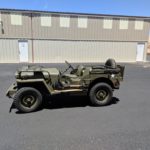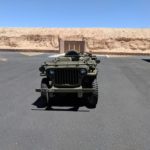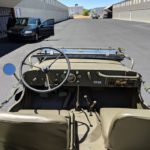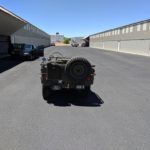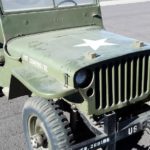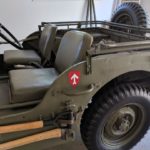History
WWII Jeeps
Designed in one month by the Bantam Car Company in Butler, PA, the first prototype Jeep, then known as the BRC or Bantam Reconnaissance Car, made its debut in 1940. Designer Karl Probst began work on 17 July 1940 and the prototype was at Camp Holabird, MD, for testing on 23 September. Due to manufacturing requirements, contracts for the Jeep were granted to the Willys-Overland Motors on 7 Jun 1941 and then the Ford Motor Company on 19 Nov 1941. Between both companies, 647,870 Jeeps were produced from 1941 to 1945. The Jeep was developed as a light command and reconnaissance car to meet the specific tactical needs of the American Army at a time when world scale war seemed imminent. Because of industrial war mobilization, the Jeep makers could neither properly advertise it nor sell it to consumers. Yet, before WWII was over, the Jeep had achieved universal popularity. Almost every person on earth knew the Jeep and knew that he wanted to own one. Seven decades later, the WWII Jeep is still instantly recognizable and a highly desirable and much sought-after collectors’ vehicle in its original form. Military Jeeps, known as Willys MA/MB (Model A or Model B) and the Ford GPW, were informally called Jeeps from either its Ford production name of GPW (General Purpose Willys) or from the Popeye cartoon character of Eugene the Jeep. Willys-Overland was able to copyright the name “Jeep” on 13 June 1950.
Do you have a veterans story or pictures you would like to submit?
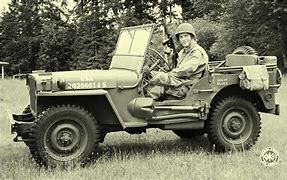
A Willys Jeep on duty in 1943
jeep/n: A small general purpose motor vehicle with an 80 inch wheelbase, 1/4 ton capacity and four-wheel drive used by the US Army
RECovery
1942 FORD Gpw
In November 2018, LT Col Koloc was made aware of a WWII Jeep that might be for sale at the Prescott, AZ airport. Upon inspection Lt Col Koloc discovered, sitting on four very sad tires, a 1942 Willys Jeep, according to the data plate on the glove box. It had been pressed into service to move aircraft and personnel around the airport. Most of her original equipment and mounting hardware had been removed and the front bumper replaced with a homemade aircraft towing pintle. Further examination of the Jeep revealed it to be a Ford GPW, not a Willys MB, as verified by the tool box covers and the front frame member. Those are two distinct differences between the Willys MB and the Ford GPW vehicles. It had also been incorrectly titled as a 1942 Willys. The purchase offer ($3500) was accepted on the spot and the GPW was moved to the African Queen hanger on the other side of the airport. Work began immediately to bring the GPW back to life with a little CPR (Conservation, Preservation, and Restoration), with the title updated to the correct nomenclature.
See pictures of more African Queen Vehicles
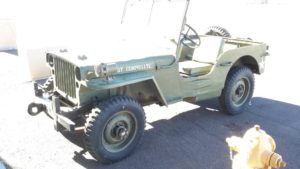
The Jeep as recovered from the hanger
In storage for 30 Years: She had been pressed into service to move aircraft and personnel around on the flight line. Most of her original equipment and mounting hardware had been removed and the front bumper replaced with a homemade aircraft towing pintle.
REStoraTION
KEEPING IT ORIGINAL
During the process of examining the jeep, it was determined that this poor vehicle was a Frankenstein of sorts. The previous owners had replaced the original windshield with a more modern one, and replaced the entire steering and emergency brake systems with ones from a later model Chevrolet. In addition, the seats were not original and the rear seat was missing. All mounting hardware for every attachment to include the correct spare tire holder, fuel can mount, shovel and axe had been removed and all the mounting holes filled in. The original rear taillights had been removed and the mounts cut out with a torch and the entire rear end of the jeep had been covered with a 1/2 inch of body putty and smoothed over. The engine was incorrect and missing the original fuel system and the original fuel pump. The battery box was entirely rusted away and the water pump was also missing. In addition all the wiring had been chewed up by rats and mice and only the ignition switch wires were intact. It was going to be a challenge to get her back into original running condition.

A bit of a Frankenstein, lots of work to get her back into running shape
A through inspection revealed that body support metal had been cut away by a torch as well as the rear taillight mounting hardware.
PReservation
KEEPING IT REAL
After acquiring the Jeep in November 2018, assessment started immediately. Once an inventory of what was missing, what had been replaced, and what had to be removed, it was clearer of what lay ahead. Currently the preserved GPW is on display at the Tri-State Air Museum in Batavia, OH. Funding is now being sought to support restoration of the the Ford GPW. For this restoration, the African Queen Project has teamed up with the Great Oaks Career Campus (GOCC), Milford OH, for a joint restoration effort. This joint “G-STEM“ program will focus on veterans who are enrolled in the GOCC adult education classes. Since 2019, $8K has been invested on the following items:
- Located and purchased a complete and original 1942 Ford Engine (The current engine is a 1944 Willys engine).
- Rebuilt and restored the original steering system.
- Rewired complete electrical system using modern wire as a stopgap so that everything now functions.
- Purchased all the correct materials to fabricate an original WWII wire harness.
- Restored switches, gauges, taillights, and headlights.
- Rebuilt complete fuel delivery system to include original filters, fuel lines, rehabbed fuel tank and correct fuel pump.
- Purchased and replaced battery box and restored the surrounding metal.
- Restored water pump and hoses with NOS (New Old Stock) parts.
- Purchased and restored all missing WWII hardware.
- Purchased original pioneer tools to include shovel, tire pump, engine crank and axe.
Current initiatives and efforts:
- Complete Ford GPW Restoration. (Engine, Axles, Transmission, Transfer Case and Body). ($8K)
- Purchase 5 new original tires with inner tubes and liners. ($800)
- Purchase new canvas top and side curtains. ($800)
- Purchase rear seat frame, correct cushions and mounting hardware. ($500)
- Purchase original front seats and correct cushions. ($500)
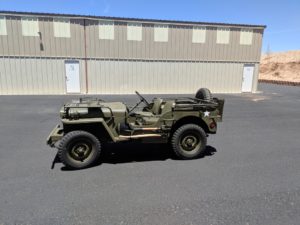
Preservation complete and we are ready to roll
“From a small company and simple beginnings came one of the iconic symbols of WWII and arguably one of the most enduring automotive designs of all time.”
Lt Col Brian Duddy (Ret) (Author: The Jeep at 70)
IMAGEs of the 1942 Ford GPW “JEEP”
